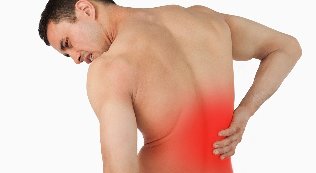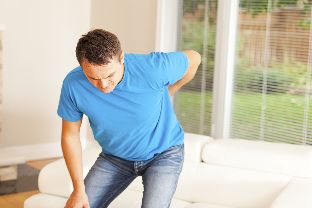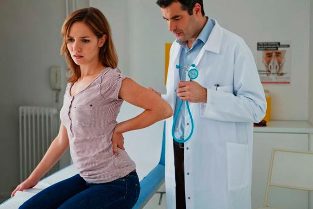Back pain - a common symptom. Most people at least once in a lifetime encounter with him. This is one of the most common reasons for visiting a doctor and skip work.

Keywords: back pain, lower back pain, spine
Lower back pain can occur at any age but is more common between 35 and 55 years. Pain in the spine associated with the way our bones, muscles, intervertebral discs, ligaments, tendons and nerves.
Lower back pain can be caused by problems with the vertebrae, the discs between them, the ligaments around the spine and discs, spinal cord and nerves, muscles, internal organs in the abdominal and pelvic areas. Also cause pain in the upper back can become a disease of the aorta, tumors in the chest and inflammation of the spine.
Risk factors
The presence of risk factors increases the likelihood for the development of the individual member. For example, obesity increases the risk for diabetes type II.
The following factors, which are associated with increased risk for back pain:
- office work;
- work, coupled with constant stress;
- pregnancy - pregnant women frequently suffer from back pain;
- a sedentary lifestyle;
- age;
- depression;
- obesity/excess weight;
- Smoking;
- heavy physical exercise;
- heavy physical labour.

The signs and symptoms of pain in the back
A symptom is something the patient feels, whereas a sign can be noticed by the doctor. For example, pain is a symptom, whereas a rash is a sign.
The main symptom of low back pain is pain in any part of the back. Sometimes the pain spreads into the buttocks and leg or shoulder and arm.
You must immediately notify physician if pain is accompanied by any of the following characters:
- loss of body weight;
- high temperature (fever);
- back pain ease after rest;
- pain that radiates into the leg;
- pain down below the knee;
- the presence of fresh injuries of the spine;
- incontinence of urine (in small doses);
- difficulty urinating - urine passes with difficulty;
- fecal incontinence - loss of control over the process of bowel movement;
- numbness in the genital area;
- numbness of anus;
- numbness in the buttocks.
Seek professional advice if you belong to one of the following groups:
- people aged under 22 or older than 55 years;
- patients who took steroids for a few months;
- patients with cancer;
- patients who once had cancer;
- patients with low immunity.
Causes of back pain
The human spine is a complex structure consisting of muscles, ligaments, tendons, disks and bones. Intervertebral discs, located between each pair of vertebrae and act as shock absorbers friction. Problems with any of these parts can cause pain in the spine. In some cases, the cause for the pain cannot be determined.

Stretching
The most common causes of back pain are:
- stretched muscles;
- stretched ligaments;
- lifting heavy objects in an incorrect posture;
- lifting too many heavy subjects;
- the result of a sudden and awkward movement;
- spasm of the muscles.
Structural problems
The following structural problems can cause back pain:
- protrusion of the intervertebral disc. Fracture of the external housing for the disk leads to vbuhanie their internal content outside. This can cause a pinched nerve and as a result, the pain;
- herniated disk - bulging of the internal disk content of large dimensions;
- sciatica sharp and shooting pain that radiates into the buttocks and back area of the leg, due to protrusion or herniation of the intervertebral disc, compression of the nerve;
- arthritis in patients with osteoarthritis commonly experience problems with the joints of the hip, lumbar spine, knees and hands. In some cases, the spinal stenosis, as the space around the spinal cord is narrowed;
- abnormal curvature of the spine - if the curves of the spine in an unusual way the patient is more likely to suffer from pain in the spine. An example of anomalous, it is scoliosis in which the spine curves to the side;
- osteoporosis - bones, including the vertebrae become brittle and porous, which leads to more injury.
Below are some other causes for pain in the back:
- cauda equina - horse tail is a bundle of nerve root that branches off the spinal cord. People with cauda equina syndrome feel dull pain in the lumbar spine and the buttocks. You can also loss of sensation of the buttocks, genitals, thigh. Sometimes people with cauda equina syndrome suffer from incontinence of urine and/or stool;
- cancer of the spine - a tumor located in the spine, can compress the nerve, leading to pain;
- inflammation of the spine - if the patient has a high body temperature and painful, hot area on the back, then it can mean inflammation of the spine;
- other infections - pelvic inflammatory disease in women, and infections of the bladder and the kidney can also cause back pain;
- sleep disorders - people with sleep disorders are more likely to experience pain in the spine compared to the General population;
- herpes zoster infection that can affect your nerves;
- bad mattress - if a mattress does not support specific parts of the body and provides a flat back position, is the risk for the development of pain in the spine.
Also cause pain in the spine, can be certain movements or body positions, such as long-term running, coughing, etc ..

What to do when back hurts
If you experience pain for a few days, then the following tips will help reduce pain and discomfort and fast recovery:
- stay as active as possible;
- if necessary, use over-the-counter painkillers;
- use hot and cold compresses. Will fit a bottle with hot water, and a bag of frozen vegetables.
Despite the fact that it was difficult to stay optimistic when you are in pain, try not to be discouraged. This will speed up the healing process.
Long-term pain, which lasts for six weeks, you should consult with your doctor. The doctor will take a medical history, conduct a review and, if necessary, sent for further studies. Your doctor may order x-rays if you suspect a problem with the skeletal system or osteoarthrosis, CT (computed tomography) or MRI (magnetic resonance imaging) with suspected intervertebral hernia or any other problems related to soft tissue and nerves. In this case, MRI is the best choice. Also, the doctor may advise you to take some lab tests or for measuring the electrical activity of the nerves (EMG).
After the diagnosis the doctor prescribed treatment. For the majority of the cases, conservative treatment, which may include:
- specific exercises;
- reflexology;
- traction of the spine;
- massage.
In severe cases, may be questioned about the operation. The surgeon will help You choose the appropriate method and advise on the possible complications. Some time after the surgery, recommends the passage of prophylactic treatment of the spine. Do not forget that surgery is very dangerous, because the operating area is located in the vicinity of the nerves.





































